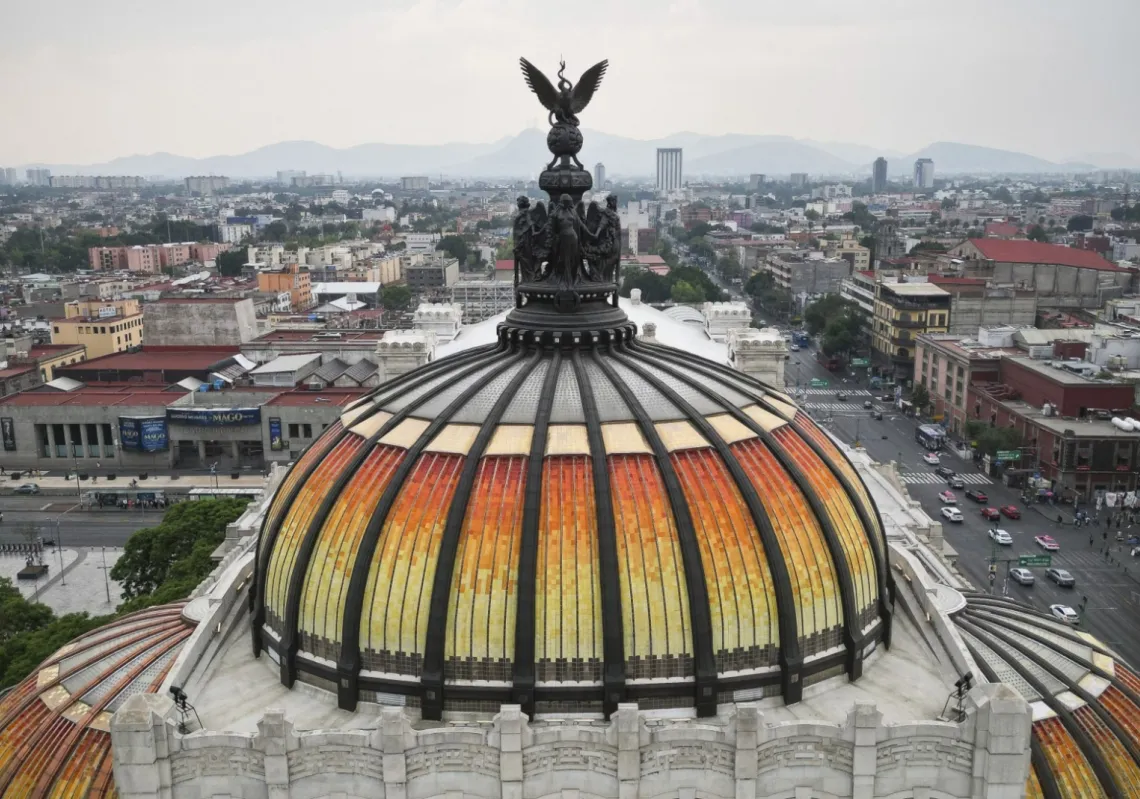From being a crumbling, bat-infested ruin to now a dazzling cultural and fashion venue, Egypt’s iconic Baron Empain Palace in Heliopolis has indeed come a long way. Often referred to as the Hindu Palace because of its architectural bow to the Angkor Wat Temple of Cambodia and the ancient temples of Orissa in Eastern India, the Palace was built between 1907 and 1911 and scored many unique architectural points – built by Belgian millionaire Baron Edouard Empain, who is also the founder of Heliopolis district, it was designed by French architect Alexandre Marcel and decorated by Georges-Louis Claude. It was built entirely of concrete, then a new building material. The facade of the two-story piece of art is richly decorated with sculptures of snakes, dragons, and other oriental mythological figures.
An engineer, entrepreneur, financier, and industrialist, as well as an amateur Egyptologist, Baron Empain was ennobled by King Leopold of Belgium. The brain behind the Paris metro, Baron Empain first visited Egypt in 1904 and fell in love with the country. He proceeded to use his considerable wealth to build a railway empire of trams. metros and electric railways.
In 1906, he bought a very large stretch of the desert (25 square kilometers) to the northeast of Cairo at a throwaway price from the Egyptian government and proceeded to build the new town of Heliopolis, ten kilometers from the center of Cairo. It was designed as a "city of luxury and leisure", with broad avenues and equipped with all the mod-cons including the historic Heliopolis Palace Hotel (formerly the presidential palace of ex-President Hosni Mubarak).
Hindu Palace in a Land of Minarets

But today, Baron Empain is perhaps best known by modern visitors to Egypt for the building of a palace (the Palais Hindou) in the Avenue des Palais (renamed Orouba Avenue following the Egyptian Revolution of 1952). The Baron had kept the choicest plot in the Heliopolis for himself so that from his terrace, he could watch the rising of Heliopolis against no less a backdrop than the 4000-year-old Giza Pyramids. He had a lot of financial interests in Indonesia and it struck him, that if he were to combine the key features of Indonesian and Indian temple architecture, it would be interesting in a land of mosques and minarets.
The separate pieces of the palace building were cast in concrete in France, according to Marcel’s designs, then shipped individually to Egypt and assembled on site. The building consisted of two floors with two additional subterranean floors. The underground floors contained a family mausoleum, a kitchen, and the servant's room. There were two elevators and even a tunnel that connected with the nearby church built by the Baron. The layout of the rooms was designed so that every room commanded a view of Heliopolis City.
The landscape surrounding the palace used to be a wonderland a long time ago, festooned with ascending green terraces each with its own set of marble statues of snakes, Indian dancers, elephants, and images of Buddha and the Hindu Gods, Shiva, and Krishna.
The first Baron Empain had entertained all of Egypt’s elite and state guests in the Hindu Palace, including King Albert and Queen Elizabeth of Belgium during their 1912 visit to Egypt.
Ruin and Rumours of Hauntings
It was the death of Baron Empain in 1929 that marked the beginning of the palace’s slow ruin. Three generations of Empains occupied the premises. The last to live there were his grandchildren, Janine and Huguette Empain who much preferred the lounges of the nearby trendy Heliopolis Sporting Club to the sepulchral halls of their grandfather’s palace. They were great friends of King Farouk, the last King of Egypt.
But it appears that somewhere in 1948, their relations soured, when Janine, in a drunken mood insulted Farouk - she demanded that waiters in a posh restaurant serve her before they attended to King Farouk and his guests, who were dining at the next table. Now, normally, King Farouk, then in his regal prime, would have brushed off the drunken jibe from a friend. But to be insulted in his own capital, Cairo, and that in public was too much. He sent a message to Janine immediately banishing the Empains from Egypt. They did not return from this exile.
Then the Egyptian army requisitioned the building during the Suez crisis of 1956, which further damaged the garden and interior. The palace, together with its valuable interiors, was eventually auctioned in 1957, since when it has been systematically stripped of all the fresco murals, the massive gilded doors, the balustrades, the beautifully designed parquet floors, and the gold-plated doorknobs. Even the famed Belgian mirrors were wrenched from their sockets, and instead of the carved ceilings reflecting off the marble floors, bat droppings littered the magnificent hallways.
The edifice eventually became home to thousands of bats and stray dogs and the inevitable rumors began to circulate: that the palace was haunted; that it was used by devil worshippers and, perhaps more credibly, by drug dealers. The once-lush gardens of the palace withered, as the municipality cut the water when the bills were no longer paid.
Sold for a Song

The palace was sold by the Baron’s family in 1957 to the families of Lebanese financiers, Alxasam and Reda and was declared as a monument later in the 80s by the Egyptian government. In the year 2000, the owners of the palace, who had bought it in 1957 for a mere Lebanese LE160,000 (equivalent to 100,000 US dollars) had offered the Egyptian Government one of two choices - either to buy the palace for the amount of fifty million dollars ($50,000,000) or to allow them to turn it into a five-star tourist project for the rich and famous. But the Egyptian Government, despite the fact that it did not have the money to buy the building, refused to allow it to be converted into a hotel.
Finally, in 2005, the Hindu Palace of Baron Empain, (known as the most famous relic in Cairo after the Pyramids) was taken over by the Archaeological Department of Egypt, thanks to the initiative of Madam Suzanne Mubarak, wife of then Egyptian President Hosni Mubarak. “I call it Walt Disney architecture,” said Yehya El Zeini, chairman of architecture at Egypt’s Supreme Council of Culture, at that time, “Pure fantasy. The palace is unique and there would be no shame bringing in international restorers," says Raafat, an eminent Egyptian architect, and added, "It should be brought back to its original state. There are plenty of old photos extant to help achieve that goal."
For the last few decades of the 20th century, nobody, except official surveyors, had been inside the building and nobody knew what treasures were left in the palace. In the early 70s, Muslim fundamentalists were enraged that, at Cairo, the citadel of Muslims, there was a Hindu palace with the icons of Hinduism represented! It appears that they told the Egyptian Government that they would buy the Hindu palace for whatever price demanded by the Egyptians and would have it demolished. The Egyptian Archaeological Department told them firmly, that irrespective of its symbols, the building represented the heritage of Egypt and they would not allow its destruction.
Later, a group of Arab businessmen wanted to lease the mansion and convert it into a modern casino. Here also they could not get clearance from the Egyptian Government.
Restoration as Cultural Heartbeat

In 2017, the rehabilitation of the palace was begun in earnest by the Egyptian Antiquities Ministry and was painstakingly carried out by the Engineering Corps of the Egyptian Armed Forces and four private companies. The price tag of the restoration came to 100 million Egyptian pounds (US$ 6 million). When the beautiful burnt sienna color of the external walls and the marble pillars were first revealed after cleaning away the dust of nearly a century, there was a hue and cry that the restoration was changing the appearance of the palace. However, Antiquities Minister Khaled Al-Anany reassured the public that the rumors were false.
"I confirm all these reports are false," he said, affirming that the ministry worked carefully to preserve the palace in a form that is faithful to its original character.
There were reports that the original steel gate and the walls of the garden of the palace had been removed and that a four-meter wall would be constructed around the palace to block passersby from watching it but the minister said this too was baseless.
Once the restoration is done, the minister said, the palace will be turned into an exhibition featuring the history of the wealthy Heliopolis suburb through various eras.
Hesham Samir, al-Anany's assistant for engineering affairs, said that the engineers of the Armed Forces oversaw the renovation works carried out by four private companies which restored the gardens, walls, marble columns, statues, and the antiques. He added that the renovation, which started in August 2017, was also observed by archaeologists from the antiquities ministry to ensure the highest levels of restoration.
Finally, in June 2020, the Baron Empain Palace was once again thrown open to eager tourists and visitors who came to admire its beauty and unusual setting.
In end-September and early October this year, as the COVID-19 crisis gradually lifted, the Empain Palace once again became a heritage point and two major international events were held there – on October 1, it was the ‘Brands and Designers of Egypt’, a day-long event that intersected Egyptian history with the local fashion scene. Earlier, on September 30, guests thronged to the Gouter 2021 Festival held under the auspices of Prime Minister Mustafa Madbouli and in the presence of Nevine Gamea, minister of trade and industry, and Khaled El-Enany, minister of tourism and antiquities. More than 17 countries participated, presenting their heritage and distinct cultures in Egypt.
As tourists and Egyptian visitors once again discover the beauty of the Empain Palace, its breathtaking Indian artistry will once again take on new life and yet another wonderful architectural wonder of Egyptian heritage will make Egyptians proud.
Read More:
Aisha Fahmy: An Italianate Palace on the Shore of Cairo Nile










